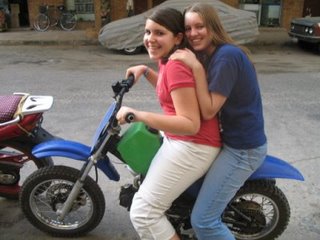Luxor
 Last week we went to Luxor (ancient Thebes) for 5 days and then stopped in Asiyut for acouple days on the way back to Cairo. Soon after we got off our sleeper train and unpacked at our hotel which was right on the nile, we went on a tour of the Valley of the Kings and Hatshepsut's Temple. We went down in to the tomb of Tuthmosis III in the side of a moutain and walked through the beautiful tomb of Ramsis IV covered in colorful hieroglyphics and coptic graffitti from the 4th century (christians hide in his tomb when being persecuted by the Romans). We even popped our heads in to Tutankhamon's tomb where there wasn't much to see but we had a fallah (farmer) fan us and point out the giant baboons painted on the walls.
Last week we went to Luxor (ancient Thebes) for 5 days and then stopped in Asiyut for acouple days on the way back to Cairo. Soon after we got off our sleeper train and unpacked at our hotel which was right on the nile, we went on a tour of the Valley of the Kings and Hatshepsut's Temple. We went down in to the tomb of Tuthmosis III in the side of a moutain and walked through the beautiful tomb of Ramsis IV covered in colorful hieroglyphics and coptic graffitti from the 4th century (christians hide in his tomb when being persecuted by the Romans). We even popped our heads in to Tutankhamon's tomb where there wasn't much to see but we had a fallah (farmer) fan us and point out the giant baboons painted on the walls. On the second day we went to a village called El Aiaisha and got to see what literacy programs and small local buisnesses that were started by BLESS which is funded by MCC. I spent most of the day coloring and doing puzzles with the children in the hadana (pre-school). On the third day we went to a village further away from Luxor than El Aiaisha. It was called Dare El Nagamish. It's 100% christian and a multitude of villagers (very excited about us visiting forigners) showed (or just followed) us around the village as Abuna Daniel took us to the projects in their village. One weird thing about this town was that there were 8 corpses laying in glass cases inside the church there. The villagers don't know who they are or when or how they died but they assume that they were monks and martyers (since all the bodies have mouths open in agony and were found buried under the church with crosses). The villagers pray over these cases.
On the second day we went to a village called El Aiaisha and got to see what literacy programs and small local buisnesses that were started by BLESS which is funded by MCC. I spent most of the day coloring and doing puzzles with the children in the hadana (pre-school). On the third day we went to a village further away from Luxor than El Aiaisha. It was called Dare El Nagamish. It's 100% christian and a multitude of villagers (very excited about us visiting forigners) showed (or just followed) us around the village as Abuna Daniel took us to the projects in their village. One weird thing about this town was that there were 8 corpses laying in glass cases inside the church there. The villagers don't know who they are or when or how they died but they assume that they were monks and martyers (since all the bodies have mouths open in agony and were found buried under the church with crosses). The villagers pray over these cases.On the fourth day we went to a monestary called Dare el Shaib. It has 33 monks and 33 domes throughout the monestary. An elderly monk showed us around the monestary and told us about his daily life there as well as the history of the monestary. There was a stone there that was used to decapitate christians during the Roman era in Egypt and the monk had many stories of miracles that took place in the monestary.
On the fifth day before we caught our afternoon train to Asiyut we went to Karnak temple and the Luxor temple. The Karnak temple was massive and grand with giant pillars decorated in hieroglyphics, a man made lake, colossal statues, and obelisks reaching high in to the sky. Luxor temple was interesting because it had a mosque built in to it and had been used as a church as well. After a lunch at McDonalds right next to the temple we were off to visit Barrette and Sandy in Asiyut.







